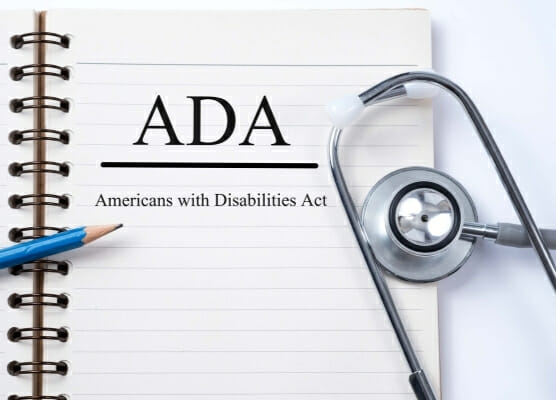Accommodate or Terminate? Firing on ADA legal considerations

Firing disabled workers is one of the riskiest moves an employer can make. The Americans with Disabilities Act (ADA) sets numerous traps. ADA terminations often spur lawsuits. Firing on ADA is treacherous. First, you must navigate the ADA accommodations process while simultaneously verifying disability. Then, you must find a reasonable accommodation that best works for your organization and test it out. If the accommodation doesn’t work, alternatives aren’t feasible and reassignment isn’t possible, then – and only then – may you terminate a disabled employee.
How to terminate disable workers legally
However, you can terminate disabled workers on the same terms and for the same reasons as other non-disabled workers. That includes poor performance, reorganizations, and other non-disability related reasons.
The ADA requires covered employers to provide reasonable accommodation to disabled employees. The accommodation must allow the worker to perform the job’s essential functions. Employers may not discriminate against an employee or applicant because the person needs an accommodation. The law protects employees/applicants with a record of having a disability as well. It even protects non-disabled workers whose employers wrongly believe they are disabled.
ADA employee rights affect termination in several ways. Let’s consider some examples:
Downsizing
Organizations must respond to change. Take, for example, the COVID-19 pandemic. Loss of business has prompted many employers to adjust their workforces. Managers may be tempted to cut employees based on the workers most likely to suffer serious COVID-19 complications. The Centers for Disease Control and Prevention (CDC) lists vulnerable workers as those over 60 or with pre-existing health problems. But those workers may be disabled. Prioritizing them for workforce cuts violates the ADA and other federal laws. The employer’s best approach is to have objective criteria for determining who gets the pink slip. The criteria should have nothing to do with disability, age or any other protected characteristic. Eliminating an entire department because you have no work due to a COVID-19 government shutdown is fine. Choosing to eliminate a disabled employee before others during a reorganization because she’s often absent for medical appointments is not.
 Poor performance
Poor performance
ADA terminations for poor performance also require careful planning. The employee may raise the need for accommodation as an explanation for poor performance. Sometimes the employee may realize the axe will fall and sees an ADA claim as a way to forestall or eliminate termination. Employers need to prepare for that trap. All employees who are poor performers should be treated the same. Employees who are not performing well should be placed on an improvement plan with specific performance targets. Those targets must be met within a set time frame. With the clock ticking, employees who need an accommodation should know it’s time to ask. If the disabled employee does not ask, simply follow the rules for all employees. But if the employee does request an accommodation, begin the interactive accommodations process while still assessing performance.
Let’s consider an example. During an ordered shutdown, you sent all employees who could telework home to do so. Most employees have performed well, meeting targets. But a disabled employee with Attention Deficit Hyperactivity Disorder (ADHD) has not. Now, he’s asking for a reasonable accommodation of additional time to complete tasks due to his disability. He explains that his children’s school is virtual due to COVID-19 and it’s hard to concentrate. The safest course of action is to begin the interactive accommodations process before firing. Remember that the employer picks the accommodation, though. You could insist the employee return to the office where there are no distractions as an accommodation. Or you could change his schedule to early morning and late evening when the children aren’t up. Then reassess his performance after a reasonable trial period.
Behavior
The ADA does not require employers to tolerate inappropriate or hostile behavior in the workplace. For example, a personality disorder like paranoid personality disorder may qualify as a disability under the ADA. But that does not mean that the employer must accept the employee’s false persecution claims against co-workers or customers. The same holds true for an employee disabled by alcoholism or drug addiction. You can enforce rules against intoxication at work as you would for all employees.
ADA disability leave
Many organizations have leave policies that include automatic termination once all earned leave has been exhausted. This is another area where ADA terminations can mean a lawsuit. Automatically terminating a disabled employee who needs time off may violate the ADA. Disabled employees may be entitled to additional unpaid leave under the ADA after exhausting all other leave. Sometimes an employee has a condition that qualifies as both a disability (ADA) and a serious health condition under the Family and Medical Leave Act (FMLA). However, when employees exhaust their FMLA leave and are still unable to return to work, leave as an accommodation under the ADA comes into play.
Consider this example. An employee takes the new paid Families First Coronavirus Response Act (FFRCA) leave when she develops COVID-19. After two weeks, she has not recovered. In fact, she’s still hospitalized and takes 12 weeks of unpaid FMLA leave for a serious health condition. Her employer runs her company paid sick leave concurrent with her FMLA leave. 14 weeks after her COVID-19 diagnosis, she’s returned home, still weak, and unable to work. Her doctor has diagnosed her with post-COVID myocardia and says she needs another six weeks off. Her employer must consider the unpaid leave request as a request for a reasonable accommodation before discharging her.
ADA accommodation essentials
The ADA requires an employer to show it engaged in the ADA’s interactive process to find a reasonable accommodation. Employees can win in court by showing the employer refused to provide a reasonable accommodation. The employer can defend that charge by showing that the accommodation the employee requested constituted an undue hardship. Accommodations can be undue hardships if they are too expensive or too disruptive to the workplace.
To ensure you have evaluated all possible accommodations, you will need to do some research. The prime place to start is the Jobs Accommodation Network (JAN) at http://askjan.org/. JAN’s database walks employers and employees through accommodation options through a series of questions. Employers should use JAN for every accommodation request and document the process. If challenged in court, the employer can show its good faith effort to find an accommodation.
All accommodations are designed to allow the disabled employee to perform the job’s essential functions. Those essential functions are listed on the job description. Employers must ensure job descriptions are up-to-date. Specifically, they must reflect current working conditions such as telework, social distancing, and other COVID-related modifications.
ADA and COVID issues
COVID has changed the accommodation landscape. For example, prolonged isolation may produce mental health issues that would not have occurred in the workplace. If you have an Employee Assistance Program (EAP), they may have to offer counseling via Zoom. Employees may need deadlines moved or other accommodations to cope with COVID-related stress.
For those in the workplace, the constant threat of coronavirus contact may take a mental toll as well. The ADA may cover more conditions now than before COVID. Employees with underlying conditions that put them at higher risk may request an accommodation to reduce their risk.
The CDC now lists obesity (specifically, a Body Mass Index of 30 or more) as an independent COVID-19 risk factor. Traditionally, obesity has not been viewed as an ADA disability. However, because of the increased risk of severe COVID-19 illness or even death, that may have changed. Certainly, an obese employee who develops serious COVID-19 illness is at least temporarily disabled. We don’t yet know if those who recover may have permanent disabilities.
However, not every individual who contracts COVID-19 will be disabled. Those with mild illness or who are asymptomatic are not disabled. Others may be depending on the severity. As with other purported disabilities, each worker’s condition must be assessed on an individualized basis.
Return to work and reasonable accommodation
Employers who require employees to be 100% healed before returning to work also violate the ADA. Again, the lack of an interactive process is the reason. When an employee seeks to return to work, the employer should determine first whether the employee can perform the job’s essential functions with or without a reasonable accommodation. If an accommodation is needed, the employer must work with the employee to identify accommodation options.
Ending an ADA accommodation
Many ADA lawsuits occur because an accommodation that was working ended. If the employer ended the accommodation, it must go through the same process as denying one. The employer must show that continuing the accommodation constitutes an undue hardship. Each employer’s situation is different, but the factors involved in the undue hardship analysis are:
- An inability to ensure a sufficient number of employees to accomplish the work required;
- A failure to meet work goals or to serve customers/clients adequately;
- A need to shift work to other employees, thus preventing them from doing their own work or imposing significant additional burdens on them; or
- Incurring significant additional costs for adaptive technology or payroll.
Employers should never deny any accommodation request without performing this analysis. Courts will demand to see the employer’s reasons.
Employers who end an accommodation must show that something has changed from when the accommodation worked. The job description could have changed. In this scenario, employers would have to show the job description for all workers performing that job changed. Otherwise, the disabled employee could claim the change was a pretext for firing.
Unfortunately, a disabled employee’s health may deteriorate, rendering a working accommodation useless. The employee must request the new accommodation just as the employee had to request the initial accommodation. If it turns out the employee can no longer perform the essential functions of the job, with or without reasonable accommodations, it’s time to discharge the employee.







